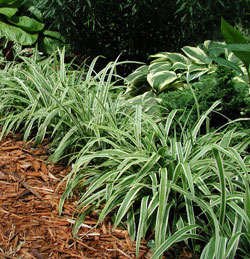Resource Library
Plant of the Week: Sedge
The University of Arkansas System Division of Agriculture does not promote, support or recommend plants featured in "Plant of the Week." Please consult your local Extension office for plants suitable for your region.
Plant of the Week
Sedge
Latin: Carex siderosticha ‘Variegata’ Broadleaf Sedge

I must be getting old and lazy, for I find myself developing a keen appreciation for easy to grow plants. One that has caught my attention is the variegated form of broadleaf sedge, Carex siderosticha 'Variegata'.
Sedges are grass-like plants with leaves arranged in clusters of three. Cut the emerging shoot in a cross section near the base, and you can plainly see the triangular arrangement common in all the 2,000 species of sedges.
Broadleaf sedge is a deciduous species that reappears in early April and dies away with the first frost. It’s cold hardy through zone 6 and will grow throughout Arkansas. It has long, inch-wide grass-like leaves that arch gracefully from the base of the plant and grow to 18 inches long, forming a mound of foliage about a foot tall. Other than the flower spike, this sedge does not have an above ground stem.
The variegated form with broad white stripes running the length of the leaf seems to be the only selection offered in the nursery trade. In sunny locations, the white stripe will turn to gold as the summer heats up.
As leaves emerge in the spring, the plant sends up 18-inch-tall spikes of flowers that have no ornamental appeal. I usually snip these off as they appear to keep the plant tidy.
Plants spread fairly quickly by means of an underground rhizome. I planted a row of divisions along the side of a garden path in 2003. In three years, this planting has spread to a solid row about a foot across with the leaves arching out to form a 2-foot-wide border.
This showy ornamental sedge seems to have appeared on the scene about 1990 with the first wave of the new plant craze. I don’t find it mentioned in any of my standard references published before that date.
It was probably introduced to this country by Maryland nurseryman Kurt Bluemel, the man responsible for introducing so many ornamental grasses to the American nursery trade. His 1992 catalog lists 26 sedges, including this species.
But where did Blumel get it from?
Broadleaf sedge was described as a new species in 1873 when Henry F. Hance (1827-1886) published a paper adding a supplement to a previously published book on the flora of Hong Kong Island. It was one of 24 new species he described in the supplement.
Hance was employed in the British Council’s office in Canton after the second Opium War ended in 1860. But botany was his passion, so he devoted all of his leisure time to studying the flora of this newly opened country.
Hance didn’t travel into China to collect plants but bought collections of those who did and became well known in botanical and horticultural circles during the period.
Possibly the plant was introduced to Europe during this period, but I find no reference stating this. By 1985, it was described matter-of-factly in the German bible of winter hardy herbaceous perennials by Jelitto and Schacht. German nurserymen were especially keen on grasses, so they may have been the source for the plant.
Sedges have a place in many gardens because they look a lot like grass but, unlike most grasses, they will tolerate shade. I use mine to border woodland walkways or as a spot of color in shaded areas. Broadleaf sedge does best in reasonably good soil that’s irrigated during the summertime. It has no pest problems that I have seen and has shown no evidence of spread by seed.
By: Gerald Klingaman, retired
Extension Horticulturist - Ornamentals
Extension News - August 4, 2006
The University of Arkansas System Division of Agriculture does not maintain lists of retail outlets where these plants can be purchased. Please check your local nursery or other retail outlets to ask about the availability of these plants for your growing area.